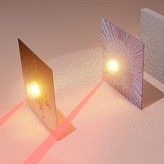Lasers for understanding magnetic instabilities in astrophysics


Ion radiography of Weibel instability: protons accelerated by laser-plasma interaction in a first target (left) pass through a second target, itself irradiated by another laser beam (middle and framed). The Weibel instability induced there by energetic electrons (blue trajectories) generates magnetic fluctuations that deflect the protons onto a series of sensitive films (right), producing an image of the resulting magnetic structures (credit : David Tordeux).
Julien Fuchs' research team at the Laboratoire pour l’utilisation des lasers intenses (LULI*) measured the magnetic fields produced by Weibel instabilities created within a laser-driven plasma. These instabilities, predicted by theory about 50 years ago, produce a magnetic turbulence which, in astrophysical settings, could be responsible for the acceleration of cosmic rays and the emission of gamma photons in the famous “gamma-ray bursts”. By working on the interpretation of their results with Laurent Gremillet and Charles Ruyer of the Commissariat à l'énergie atomique et aux énergies alternatives (CEA), they demonstrated that these instabilities extend over a much greater distance than anticipated from other experiments on the subject.
Their work was published in Nature Physics.
Unstable plasmas
Stars, nebulae, interplanetary, interstellar or intergalactic media: plasmas make up almost all of the visible universe. These ionized gases in which electrons and atomic nuclei are dissociated under the effect of heat are subject to fluctuations linked to their environment. They can also generate self-amplified electromagnetic waves called instabilities. Among these are the “Weibel instabilities”, which arise in plasmas having a preferred direction along which the particles are the fastest.
Indeed, electrons caught in these instabilities will be like runners launched at high speed and bound by invisible links (electromagnetic fields). These links induce slight changes in the trajectories of each rider, changes that eventually cause the riders to lose overall speed and disorganise the whole group. This induces a loss of energy for the electrons while at the same time the electromagnetic fields become stronger.
Understanding instabilities
To better understand this phenomenon, Julien Fuchs and his collaborators conducted experiments at the Lawrence Livermore National Laboratory (USA) using a technique developed at LULI over the last ten years: by producing a beam of protons with a first laser beam, they probe the magnetic fields created in a target irradiated by a second beam. The formation of quasi-periodic magnetic structures, up to amplitudes of several Teslas, has thus been revealed at unsuspected scales. Their interpretation by CEA physicists then required several years of effort, combining theoretical modelling and advanced numerical simulations. In doing so, two variants of Weibel's instability were highlighted according to the region of the plasma - its dense core or its surfaces expanding towards the vacuum - traversed by the energetic electrons, each of these instabilities giving rise to a distinct spatial configuration.
If the analysis of the experiment has taken so long, it is because the current computing capabilities are still insufficient to simulate it in three dimensions, while describing all the underlying processes, and thus take over from the necessarily simplified theory. But this shows the interest of ultra-high intensity lasers to reproduce and characterize these complex phenomena, of fundamental interest as astrophysics. The imminent commissioning of the Apollon facility should enable researchers to reach even more extreme physical conditions, bringing them a little closer to the astrophysical phenomena in question.
* LULI, a joint research unit CNRS-École Polytechnique-CEA-Sorbonne Université
 Support l'X
Support l'X